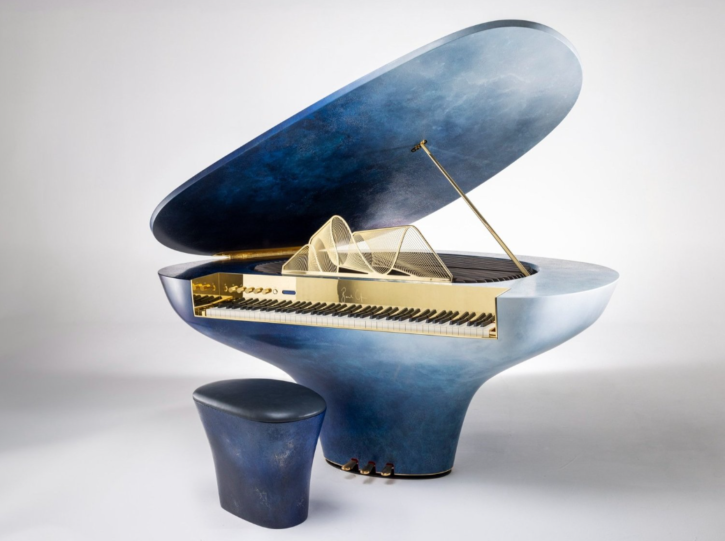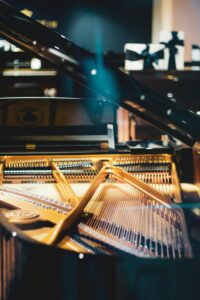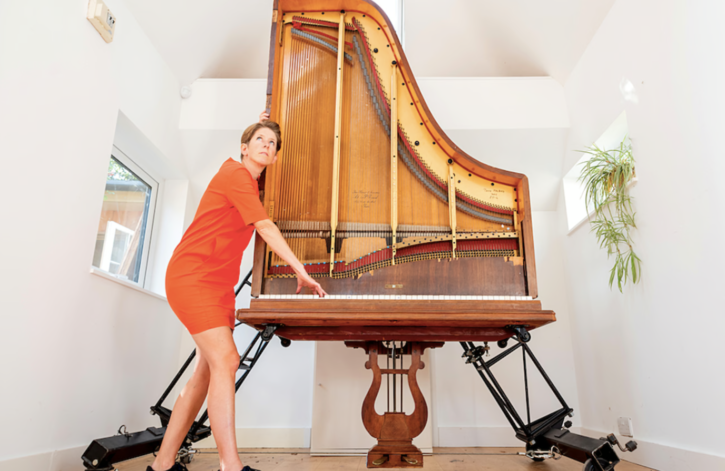Header Title
Perceptions about pianos – battles born to be lost?
Product of evolution
In the world of keyboard musicifying, grand pianos are pretty much top of the league by most parameters – size, cost, weight and prestige. I’m a near-total music ignoramus, but I reckon they’re probably ranked as nobility among the multitude of different musical machines used to perform classical music.
Influences on piano design
But the designs and capabilities of grand pianos haven’t changed much for more than three centuries. Hardly anyone queries this setup, because it’s enmired in tradition and in centuries of conventional perceptions about performing classical music. And because viable alternatives are lacking.
For us mere mortals, the insides of grand pianos look dauntingly complicated. When a concert piano is being played, the lid is (usually) open, but most of the audience can’t really see anything actually happening, except for the soul-wringing exertions and gyrations of the player-person. It’s difficult for newbie music “customers” like me to work out how and where the sound is actually produced – it just magically emanates from within the mysterious “edifice”. Considerations like transparency, inclusivity and audience involvement are certainly not on the agenda – the design and engineering of pianos date from long-bygone eras in which the basic premises were entirely different.
But multiple aspects of the business model of performing classical music are in apparent flux (some say crisis), with declining audiences, changing demographics and technology-driven patterns of music consumption and mind manipulation. Could there be room for a rethink, perhaps even a necessary rethink to help save the professional bacon of a threatened species?
Identifying the value proposition
But where would such change come from, and which “value propositions” could be involved as drivers, motivation and metrics? One-off dashes of ker-pow design brilliance are never going to shift overall perceptions, build market share or alter the path forward for keyboard capabilities. In fact, they will often be exceptions that help prove and maintain the rule, a way for maverick forces to blow off creative steam without rocking the mainstream boat.
The design dimension
Established designs (of anything) are always good targets for design exuberance and innovation. Design is a very tangible differentiator in a largely unidirectional world – often an effective way to carve out a limited-volume market niche. However, it’s worth considering that stunning looks don’t always add up to concert-grade musical output that’ll satisfy the feinschmeckers of the classical music world. For the discerning listener, even minute differences mean a lot.
Exclusivity makes it possible to establish standout narratives and high-impact marketing positions without altering mainstream perceptions. Exclusivity can also make it possible to charge a high price and pave the way to acceptable returns on investment with even small production volumes.
On the other hand, innovative design and accompanying exclusivity can render such piano designs as mere idiosyncratic curiosities that may be visually appealing or eye-catching novelties, but do not in any way alter mainstream perceptions about how a piano functions, is perceived and how it can be used for interaction between the player and the public. Perhaps the poster child of this approach is the gorgeously different Ravenchord piano.

Ravenchord piano as shown on the Whipsaw website
Other radical piano designs include the Twist / D and other spectacular artist-designed luxury pianos from companies like Based Upon in London, the sculptural Exxeo Hybrid Piano designed by Iman Maghsoudi and built of carbon fibre, and the Roland Concept Model Piano to celebrate the Japanese (digital) instrument maker’s half-centennial. But all of these are design-driven, and with price tags that keep them from ever being a commercially significant path forward.
Engineering-driven rethinks
In engineering terms, one of the biggest constraints on how zany piano design can get has been the need for an immensely strong frame across which to tension all the strings/wires and on which to mount the multitude of mechanical fixtures. Traditionally, this frame has been made of iron or steel, which almost inevitably translates to structures that are big and heavy.
But grand pianos don’t have to adhere to the horizontal plane, with all the space constraints and transport difficulties this centuries-old configuration entails.
The largest upright piano ever built (as far as I can research) was the M450i Vertical Concert Grand, designed by David Klavins. The VCG series, culminating in the M450i, is 4.5 metres high and 2.2 metres wide. This towering instrument boasts a soundboard three times larger than a traditional concert grand piano, thus delivering unparalleled resonance and depth – according to the cognoscenti. Klavins is a Latvia-based piano maker who designs instruments that often shred the conventions of piano construction, rethinking key components of what makes a piano produce its distinctive sound – and then rearranging and reconfiguring these.
David Klavins also collaborates with Sarah Nicolls, who seems to be more performance-oriented, playing the tensioned wires as well as the keys. Sarah Nicolls put together the Inside-Out Piano, a re-worked 1900 Erard grand piano, to explore new sonic universes – an example of how cross-fertilisation of skills, capabilities and mindsets can lead in new directions.
From that Sarah Nicolls Kickstarter-launched another design. The Standing Grand from Future Piano claims to provide the acoustics of a concert-grade grand piano in the footprint of an upright. Instead of adopting an electronic solution, it places the strings vertically in a straight-strung configuration that gives the performer access to every part of every string, unleashing new realms of musical experimentation in addition to the practical benefits of a vertical configuration. To deal with the immense tension forces, the prototype Standing Grand makes use of an innovative structural frame built of composite materials, based on specialist engineering from Jigsaw Structures. The resulting combination of groundbreaking layout and lightweight materials means a Standing Grand apparently only weighs about 82 kg, instead of 450 kg for a traditional grand piano. Your piano can now go with you, anywhere, anytime.
The Future Piano Kickstarter project for building a hybrid demonstrator was way back in 2019, and unfortunately the Future Piano Ltd website now seems to be just a placeholder relic of a good idea. It would be interesting to know what happened when artistic creativity crossed paths with the harshness of real-world commercial realities.
Musical performance, output quality
The conceptual perspective embedded in the design and engineering of traditional grand pianos focuses solely on the sound source – electronic or perceptual augmentation isn’t allowed. If an idea isn’t broken, why try to fix it?
If you want to get serious about reconsidering and rethinking any kind of keyboard instrument (or other classical/traditional music instruments), you also have to consider the multitude of aspects associated with musical performance and output quality. Everything is embedded in a complex multivalent context, with dimensions that include historical, artistic, professional, infrastructure and commercial requirements and concerns.
For example, aspiring and accomplished professional musicians make immense investments in mastering one highly specialised tool (they call it an instrument, of course). They undertake massive personal choices and de-selections of other activities, often with big personal impacts. That’s why it is unreasonable to expect any individual musician to make a “professional sacrifice”, abandon comfort zones and jump ship to new, unfamiliar or not-really-accepted configurations of the tools of his or her trade.
Perspectivised piano?
Many aspects of classical music are struggling to survive within traditional ivory-tower structures rooted in bygone realities and social structures. Audiences are ageing and being marginalised, and in many places the traditional use of concert pianos is being out-competed and market-nibbled by other forms of performance, entertainment, artistic appreciation, leisure and socialising, as well as new ways of getting these from source to recipient, from musician to audience.
And then there’s an entire spectrum of electronic gizmos, toys and tools … Let’s be honest; most of us mere mortals can’t hear the difference in sound source, especially through the cheap, tinny computer speakers and in-ear pods that are increasingly the prevalent medium for consumer-grade music and other sound.
At the same time, music practitioners now have a much wider palette of artistic choices, role models and commercial channels available to them, YouTube is one of the biggies, of course. Combinations of (phone) cameras available to almost everyone everywhere and YouTube-like content outlets effectively remove most of the concert hall and venue restrictions, delivering each performer and his/her/their capabilities direct from source – whether the player’s bedroom or a Moldovan cow barn – right into the eyes and ears of each member of his or her potential audience. This opens up a multitude of new segments of musical performance and enjoyment – whether arcane or innovative – to worldwide audiences only a proverbial keystroke away.
Whatever its design configuration, the venerable piano then transitions from its original positioning as the player’s “single point of truth” in traditional performance delivery environments. Instead it becomes just one element in a long, multi-variable supply chain of experiences and recipient perceptions, a mouthpiece out to a fluid audience not defined by geography, with the focus more on entertainment delivery value than on precision execution at the point of origin. In such deconstructed artistic models and delivery frameworks, the piano becomes what you make it.
Keeping the piano “pure”?
But YouTube and its ilk can also serve to keep the piano (relatively) “pure”, perhaps in new-perspective formats.
For example, there’s the seven young members – including twins and triplets (= 14 hands! And at one point 5 people on the keyboard here) – of the Rogers Family from Atlanta, Georgia playing – and playing with – the many different sound-producing surfaces, structures and fixtures of a piano. They seem to be the next generation following on from the Piano Guys model, with its now-somewhat Disneyfied conceptual packaging.
Perhaps unfortunately for the theme that this blog post started out from, both of these performance groups still rely on more-or-less traditional(-looking) pianos. So perhaps the rethinking lies in the performance artisan, rather than the “mere” tools?




